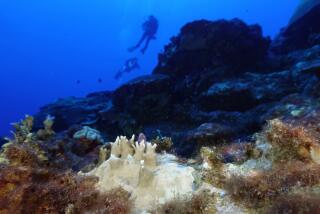The Sea Wore Black: in Mourning for Eastern Europe’s Polluted Waters : Environment: Years of neglect may kill the Black Sea. Economic, political woes in nations that ring the body of water do not bode well for cleanup.
- Share via
ODESSA, Ukraine — Flooded with pollutants from land, water and air, racked by civil war on one coast and packed with tourists on others, trapped in the midst of one of the world’s great political and economic transformations, the Black Sea, the dirtiest sea on Earth, is dying an agonizing death.
In just 30 years this sea, famed since the times of Ovid and Herodotus for its rough storms and rougher inhabitants, has degenerated from one of the most productive bodies of water to a cesspool--a dumping ground for vast quantities of phosphorus, inorganic nitrogen, oil, mercury and DDT cast off by the 160 million people of the Black Sea Basin.
It is a region struggling to come to terms with environmental crisis after decades under centrally planned economic systems notorious for their disregard of nature. The death of the Black Sea would represent a major defeat in the campaign to clean up the mess left by communism. And the demise of the Black Sea would stand as a chilling prophecy for the world’s other seas.
Of the 26 species of fish caught in the Black Sea in the 1960s, only five remain. In less than 10 years the mackerel catch, once the mainstay of the fishing industry, has plummeted from nearly 700,000 tons a year to 100,000 tons.
More than 1 million dolphins frolicked in the Black Sea 30 years ago; now their number has dwindled to about 200,000. Many dolphins are infected with swine fever--probably contracted from pig farm wastes dumped into the Danube River delta. The monk seals have disappeared. In 1993, a Bulgarian hotel developer blew up the last of the coastal caves the seals called home.
Oysters and blue mussels, known as the “kidneys of the sea” because they filter the water, also are vanishing. The sea’s lungs--rich meadows of bottom-growing algae and sea grass that occupied 4,200 square miles along the sea’s once-fecund northwest shelf--have shrunk to a tenth their previous size.
Since the 1970s, cholera outbreaks have become common because sewage treatment plants are few. Beaches throughout the region, the only warm-water vacation within the former Soviet borders, are often closed to bathers because of foul-smelling pollution and suffocating blooms of harmful surface algae and other phytoplankton.
One such bloom in 1991 is believed to have killed 50% of all the bottom-feeding fish along Romania’s coast. It turned the beaches around Constanta into a “long line of death, an apocalypse,” according to Radu Mihnea, a biologist at the Romanian Marine Research Institute there.
Against heavy odds, late last year a project backed by the United Nations and the World Bank began to tie together various efforts to save the Black Sea. The Environmental Management and Protection Program of the Black Sea, based in Istanbul and led by British marine biologist Laurence Mee, has a three-year budget of just $25 million. Its mission is to coordinate research and identify the most urgent cleanup efforts.
The United Nations’ Global Environmental Fund, which supports the program, has been accused of whitewashing environmentally risky developments favored by the World Bank, but the Black Sea effort has escaped that kind of criticism. “In this case, anything they do would be an improvement,” said one official of Greenpeace, the private environmental group. “But, like all U.N. things, they like meetings too much.”
This year, Ukraine became the last of the Black Sea countries to approve a convention establishing the legal tools to get control of maritime pollution. And all six--Georgia, Russia, Ukraine, Romania, Bulgaria and Turkey--have begun negotiating a second convention that would place limits on fishing.
Meanwhile, economic disaster and political chaos in the former Soviet republics of Russia, Georgia and Ukraine, as well as in Bulgaria and Romania, do not bode well for a cleanup effort that will cost billions of dollars.
Although all the countries have agreed to conduct environmental impact assessments of major projects, construction of an oil terminal near Odessa began in February without any such precaution.
“It is technically illegal, but we don’t have laws here anymore,” said Valery Mikhailov, director of the Ukrainian Scientific Center of Marine Ecology in Odessa, which should have done the report. “If (the terminal) opens, it will ruin whatever beaches we have left.”
Representatives of all six countries bordering the Black Sea were to have met in June, but only those of Bulgaria, Turkey and Romania showed up. Russia said its invitation arrived too late. Ukraine begged a lack of funds. Georgia’s excuse was its civil war.
The sea, a lake of 160,000 square miles, was formed about 8,000 years ago. A shifting of tectonic plates suddenly connected it to the world’s oceans by the Bosporus--a narrow, 19-mile-long waterway that leads into the Mediterranean Sea. This peculiarity--similar to an Olympic-sized pool being drained through a keyhole--has created enormous problems for the Black Sea.
The lack of good drainage mechanism in effect made two seas --one of the world’s most fertile bodies of water lying atop a huge, dead puddle. Below 450 feet, the Black Sea contains no oxygen and supports no life. It is only above that depth that fish and other marine life survive.
The two layers are prevented from blending for much the same reason that oil and water do not mix: The lower water is saltier and denser than the upper, so much so that scientists estimate it would take a molecule of water on the bottom 100 years to travel to the surface.
“This is its ecological fate,” said Ukrainian marine biologist Yuvenaly Zaitsev, 70, one of the foremost experts on the sea. He remains an avid snorkeler in its dying waters.
At depths of less than 450 feet, especially along its northwest coast, the Black Sea once swarmed with life. Its northern arm, the Sea of Azov, was the world’s second-most-productive fishery, after the Chesapeake Bay. The whole Black Sea was five times more productive per acre than its larger neighbor, the Mediterranean.
Immense meadows of red algae on the shelf’s bottom served up huge doses of agar, which is used as a base for bacterial cultures as well as natural dyes and raw materials for pharmaceuticals. Bays and inlets yielded large catches of blue mussels and oysters.
“We were crazy with fish,” recalled Nikolai Prodaivoda, 51, a fisherman at the Black Sea Collective Fish Farm in Vapnjarka, a village 20 miles north of Odessa where the motto “Our Goal Is Communism” still adorns the wall of a dilapidated boathouse.
More to Read
Sign up for Essential California
The most important California stories and recommendations in your inbox every morning.
You may occasionally receive promotional content from the Los Angeles Times.










